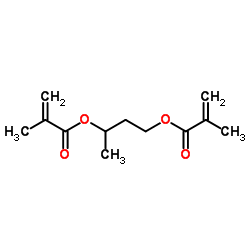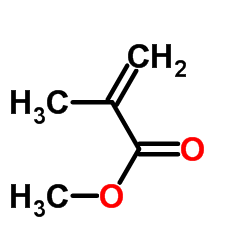UNII:OL56191M6N
Modify Date: 2024-01-02 16:41:54

UNII:OL56191M6N structure
|
Common Name | UNII:OL56191M6N | ||
|---|---|---|---|---|
| CAS Number | 1189-08-8 | Molecular Weight | 226.269 | |
| Density | 1.0±0.1 g/cm3 | Boiling Point | 290.5±13.0 °C at 760 mmHg | |
| Molecular Formula | C12H18O4 | Melting Point | N/A | |
| MSDS | Chinese USA | Flash Point | 135.1±18.2 °C | |
| Symbol |

GHS07 |
Signal Word | Warning | |
| Name | 1,3-Butanediol Dimethacrylate |
|---|---|
| Synonym | More Synonyms |
| Density | 1.0±0.1 g/cm3 |
|---|---|
| Boiling Point | 290.5±13.0 °C at 760 mmHg |
| Molecular Formula | C12H18O4 |
| Molecular Weight | 226.269 |
| Flash Point | 135.1±18.2 °C |
| Exact Mass | 226.120514 |
| PSA | 52.60000 |
| LogP | 2.61 |
| Vapour Pressure | 0.0±0.6 mmHg at 25°C |
| Index of Refraction | 1.451 |
|
1,3-Butanediol Dimethacrylate (stabilized with MEHQ) Revision number: 6
SAFETY DATA SHEET Section1. IDENTIFICATION Product name:1,3-Butanediol Dimethacrylate (stabilized with MEHQ) Section2. HAZARDS IDENTIFICATION GHS classification
PHYSICAL HAZARDSNot classified
HEALTH HAZARDS Skin corrosion/irritationCategory 2 Category 2A Serious eye damage/eye irritation ENVIRONMENTAL HAZARDSNot classified GHS label elements, including precautionary statements Pictograms or hazard symbols Signal wordWarning Hazard statementsCauses skin irritation Causes serious eye irritation Precautionary statements: Wash hands thoroughly after handling. [Prevention] Wear protective gloves/eye protection/face protection. IF IN EYES: Rinse cautiously with water for several minutes. Remove contact lenses, [Response] if present and easy to do. Continue rinsing. If eye irritation persists: Get medical advice/attention. IF ON SKIN: Gently wash with plenty of soap and water. If skin irritation occurs: Get medical advice/attention. Take off contaminated clothing and wash before reuse. May cause polimerization. Other hazards which do not result in classification Section3. COMPOSITION/INFORMATION ON INGREDIENTS Substance/mixture:Substance Components:1,3-Butanediol Dimethacrylate (stabilized with MEHQ) Percent:>95.0%(GC) CAS Number:1189-08-8 Synonyms:1,3-Butylene Glycol Dimethacrylate (stabilized with MEHQ) Chemical Formula:C12H18O4 MEHQ) Section4. FIRST AID MEASURES Inhalation:Remove victim to fresh air and keep at rest in a position comfortable for breathing. Get medical advice/attention if you feel unwell. Skin contact:Remove/Take off immediately all contaminated clothing. Gently wash with plenty of soap and water. If skin irritation or rash occurs: Get medical advice/attention. Eye contact:Rinse cautiously with water for several minutes. Remove contact lenses, if present and easy to do. Continue rinsing. If eye irritation persists: Get medical advice/attention. Ingestion:Get medical advice/attention if you feel unwell. Rinse mouth. A rescuer should wear personal protective equipment, such as rubber gloves and air- Protection of first-aiders: tight goggles. Section5. FIRE-FIGHTING MEASURES Suitable extinguishingDry chemical, foam, water spray, carbon dioxide. media: Unsuitable extinguishing Solid streams of water media: Specific hazards arising This substance may polimerize explosively when heated or involved in a fire. from the chemical:Container may explode when heated. Combat fire from a sheltered position. Precautions for firefighters: Fire-extinguishing work is done from the windward and the suitable fire-extinguishing method according to the surrounding situation is used. Uninvolved persons should evacuate to a safe place. In case of fire in the surroundings: Keep containers cool by spraying with water. Eliminate all ignition sources if safe to do so. Special protectiveWhen extinguishing fire, be sure to wear personal protective equipment. equipment for firefighters: Section6. ACCIDENTAL RELEASE MEASURES Personal precautions,Use personal protective equipment. Keep people away from and upwind of spill/leak. protective equipment and Ensure adequate ventilation. Entry to non-involved personnel should be controlled emergency procedures: around the leakage area by roping off, etc. Environmental precautions: Prevent product from entering drains. Methods and materials for Absorb spilled material in dry sand or inert absorbent before recovering it into a containment and cleaning covered container. In case of large amount of spillage, contain a spill by bunding. up: Adhered or collected material should be promptly disposed of, in accordance with appropriate laws and regulations. Section7. HANDLING AND STORAGE Precautions for safe handling Technical measures:Handling is performed in a well ventilated place. Wear suitable protective equipment. Prevent generation of vapour or mist. Wash hands and face thoroughly after handling. Use a ventilation, local exhaust if vapour or aerosol will be generated. Advice on safe handling: Avoid contact with skin, eyes and clothing. Conditions for safe storage, including any incompatibilities Keep container tightly closed. Store in a cool and dark place. Storage conditions: Store away from incompatible materials such as oxidizing agents. Light-sensitive Packaging material:Comply with laws. Section8. EXPOSURE CONTROLS / PERSONAL PROTECTION Engineering controls:Install a closed system or local exhaust as possible so that workers should not be exposed directly. Also install safety shower and eye bath. Personal protective equipment Respiratory protection: Vapor respirator. Follow local and national regulations. Protective gloves. Hand protection: MEHQ) Section8. EXPOSURE CONTROLS / PERSONAL PROTECTION Eye protection:Safety glasses. A face-shield, if the situation requires. Skin and body protection: Protective clothing. Protective boots, if the situation requires. Section9. PHYSICAL AND CHEMICAL PROPERTIES Physical state (20°C):Liquid Form:Clear Colour:Colorless Odour:No data available pH: No data available Melting point/freezing point:No data available Boiling point/range:290°C Flash point:130°C Flammability or explosive limits: Lower:No data available Upper:No data available Relative density:1.01 Solubility(ies): [Water]Insoluble [Other solvents]No data available Section10. STABILITY AND REACTIVITY Chemical stability:Polymerization may occur under the influences of heat, light or on contact with polymelization initiators such as peroxides etc. Possibility of hazardous No special reactivity has been reported. reactions: Conditions to avoid:Heat, Light Incompatible materials: Oxidizing agents Hazardous decomposition Carbon monoxide, Carbon dioxide products: Section11. TOXICOLOGICAL INFORMATION Acute Toxicity:No data available Skin corrosion/irritation: No data available Serious eyeNo data available damage/irritation: Germ cell mutagenicity: No data available Carcinogenicity: IARC =No data available NTP =No data available Reproductive toxicity:No data available Section12. ECOLOGICAL INFORMATION Ecotoxicity: No data available Fish: Crustacea:No data available No data available Algae: Persistence / degradability: No data available No data available Bioaccumulative potential(BCF): Mobility in soil Log Pow:No data available No data available Soil adsorption (Koc): Henry's LawNo data available constant(PaM3/mol): MEHQ) Section13. DISPOSAL CONSIDERATIONS Recycle to process, if possible. Consult your local regional authorities. You may be able to burn in a chemical incinerator equipped with an afterburner and scrubber system. Observe all federal, state and local regulations when disposing of the substance. Section14. TRANSPORT INFORMATION Hazards Class:Does not correspond to the classification standard of the United Nations Not listed UN-No: Section15. REGULATORY INFORMATION Safe management ordinance of dangerous chemical product (State Council announces on January 26, 2002 and revised on February 16,2011): Safe use and production, the storage of a dangerous chemical, transport, loading and unloading were prescribed. SECTION 16 - ADDITIONAL INFORMATION N/A |
| Symbol |

GHS07 |
|---|---|
| Signal Word | Warning |
| Hazard Statements | H315-H319-H335 |
| Precautionary Statements | P305 + P351 + P338 |
| Personal Protective Equipment | Eyeshields;Gloves;half-mask respirator (US);multi-purpose combination respirator cartridge (US) |
| Hazard Codes | Xi |
| Risk Phrases | R36/37/38:Irritating to eyes, respiratory system and skin . R43:May cause sensitization by skin contact. |
| Safety Phrases | S26-S36/37/39 |
| RIDADR | 3082.0 |
| WGK Germany | 1 |
| Hazard Class | 9.0 |
| HS Code | 2916190090 |
|
~% 
UNII:OL56191M6N CAS#:1189-08-8 |
| Literature: US2010/197955 A1, ; Page/Page column 4 ; |
| Precursor 1 | |
|---|---|
| DownStream 0 | |
| HS Code | 2916190090 |
|---|---|
| Summary | 2916190090 unsaturated acyclic monocarboxylic acids, their anhydrides, halides, peroxides, peroxyacids and their derivatives。supervision conditions:AB(certificate of inspection for goods inward,certificate of inspection for goods outward)。VAT:17.0%。tax rebate rate:9.0%。MFN tariff:6.5%。general tariff:30.0% |
| Butane-1,3-diyl bis(2-methylacrylate) |
| EINECS 203-786-5 |
| 1,3-Butanediol, dimethacrylate |
| 2-Propenoic acid, 2-methyl-, 1-methyl-1,3-propanediyl ester |
| 1,3-Butanediol dimethacrylate |
| MFCD00008594 |
| 1,3-Butanediyl bis(2-methylacrylate) |
| UNII:OL56191M6N |
| 1,3-Butylene Glycol Dimethacrylate |



